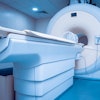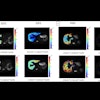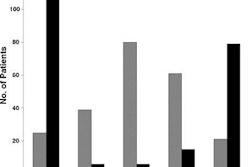KEY LARGO, FL - When ductal carcinoma in situ (DCIS) is detected with mammography, it's the microcalcifications that serve as the giveaway clue in 90% of the cases. Incidental DCIS, picked up with pathology, is still only associated with mirocalcifications in about a third of the cases. And microcalcifications do not often correlate with the extent of disease, which can mean missed DCIS.
"Underdetection and underestimation of tumor extent can lead to positive margins and treatment failure," said Dr. Steve Harms in a talk this week at the Breast Course 2007. "These are the major issues of DCIS."
Fortunately, there's MRI to address these major issues, although the right MR technique makes all the difference, according to Harms, who is a professor in the department of radiology at the University of Arkansas for Medical Sciences in Little Rock. He is also a staff radiologist at the Breast Center of Northwest Arkansas in Fayetteville and the medical director for Aurora Imaging Technology, a North Andover, MA-based manufacturer of breast MRI systems.
Indeed, previous studies have shown that dynamic MRI, even with the addition of computer-aided detection (CAD), suffers from relative insensitivity, Harms said. In fact, he suggested skipping dynamic MRI for DCIS altogether as it only results in persistent enhancement and missed disease.
Instead, Harms spoke in favor of high-resolution, high-contrast MRI, specifically a spiral RODEO technique (SpiralRodeo, Aurora Imaging Technology) with contrast agent. "The higher the quality of the pictures, the better you'll see the DCIS and the more reliable that you are going to be," he said.
First, Harms pointed out that linear and branching enhancement are typical MR features for DCIS. When using spiral RODEO MRI, resolution and contrast are very important and thinner slices are the way to go, he said.
"The enemy of breast MRI is volume averaging," he explained. "You have a duct filled with abnormal tumor cells, but that duct is surrounded by normal tissue. If your voxels are big and they encompass enough of that normal tissue, you are going to average out the enhancing lesions in the duct and you are not going to see (the lesions). What you want to do is accentuate the contrast between (normal tissue and lesions) and make your voxels as small as possible."
Ramping up the contrast and resolution will mean a drop in the quality of signal-to-noise ratio (SNR), Harms acknowledged. His answer to that is the spiral technique.
"We run out of signal with the standard MRI technique. We enhance (MRI) further with spiral imaging, which triples our signal capability," he stated, adding that spiral RODEO offers quality that is the equivalent of a 4.5-tesla scanner.
Harms' particular MRI protocol can make the difference between calling DCIS or not calling DCIS, such as the diagnosis of benign proliferative changes, he said.
Harms listed some final take-home points regarding breast MRI for DCIS:
- Low-resolution dynamic MRI will miss DCIS due to volume averaging effects.
- Slice thickness matters, with thinner equaling better (1-mm section should be the goal, he added).
- Spiral RODEO is the best technique for obtaining high resolution and high contrast while still maintaining good SNR.
- An alternative to spiral RODEO MRI is to use a 3-tesla scanner, which roughly doubles the SNR.
Finally, Harms pointed out that a noncontrast, nonspoiled spiral RODEO was basically an MR galactogram. "This comes for free with every precontrast RODEO image," he said.
By Shalmali Pal
AuntMinnie.com staff writer
March 15, 2007
Related Reading
Breast pathology lacks standardization, particularly in DCIS, March 13, 2007
Breast MR shows exceptional sensitivity for spotting DCIS, January 12, 2007
Technology, guidelines cement role for breast MR in cancer screening, May 26, 2006
Copyright © 2007 AuntMinnie.com



.fFmgij6Hin.png?auto=compress%2Cformat&fit=crop&h=100&q=70&w=100)




.fFmgij6Hin.png?auto=compress%2Cformat&fit=crop&h=167&q=70&w=250)











